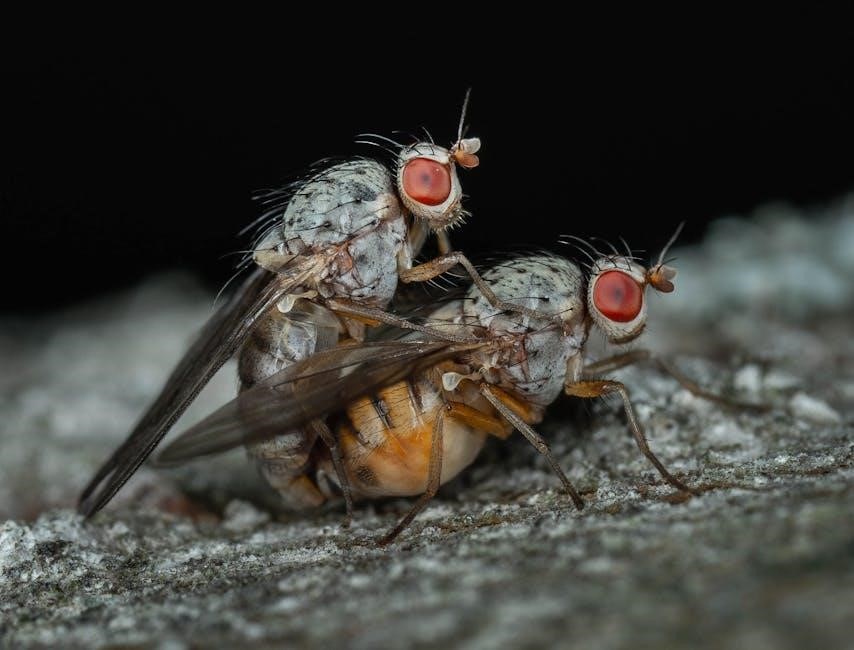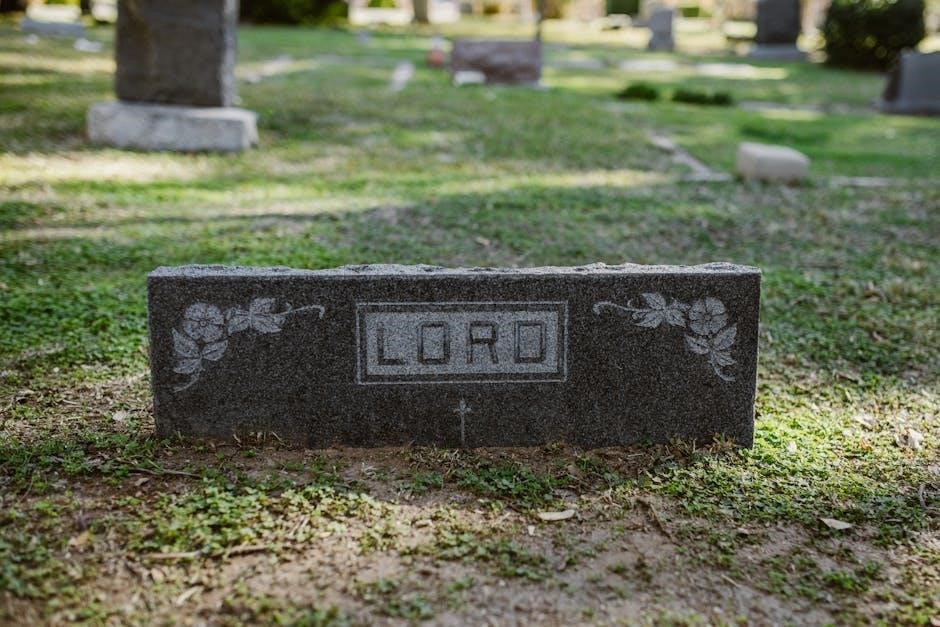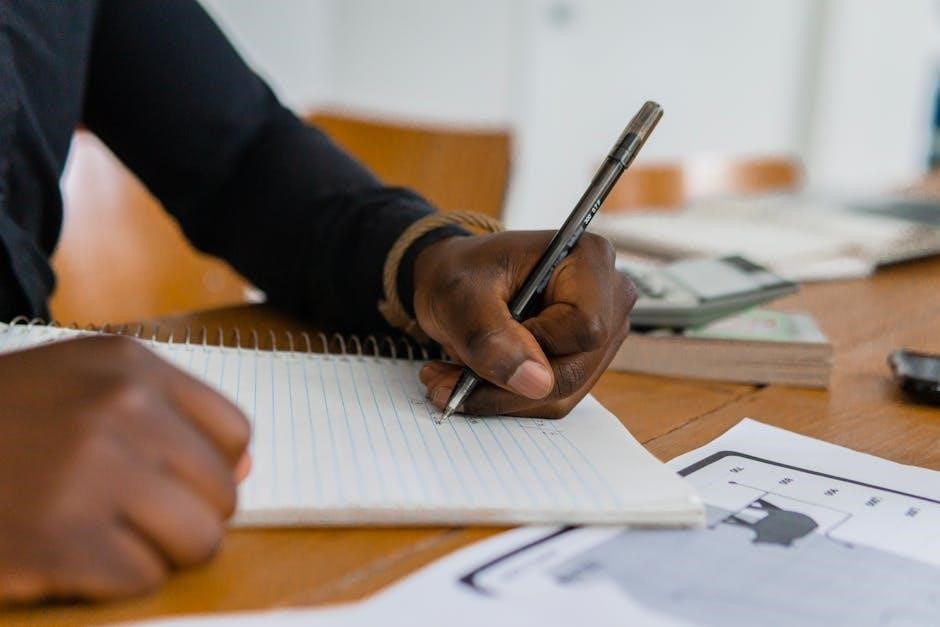William Golding’s Lord of the Flies is a classic novel exploring human nature, civilization, and savagery. Set during an atomic war, the story follows boys stranded on an island after a plane crash, revealing their descent into chaos and primal behavior. The novel examines themes of power, morality, and fear, offering a gripping reflection on society and humanity’s darker instincts.
Overview of the Novel
Lord of the Flies by William Golding tells the story of boys stranded on an island after a plane crash during an atomic war. Initially hopeful, they attempt to create a utopia but descend into chaos. The novel explores their struggle for power, fear of a mysterious beast, and the collapse of civility. The conch shell, a symbol of democracy, loses its power as savagery prevails, leading to tragic events like Simon’s death and Piggy’s fall. The boys’ rescue contrasts their primal state with civilization’s return.
Author Background: William Golding
William Golding (1911–1994) was a British novelist, playwright, and poet. Born in Cornwall, he studied natural sciences and later English literature. A teacher and Royal Navy veteran, his experiences shaped his writing. Golding’s debut, Lord of the Flies, earned him acclaim and a Nobel Prize in Literature in 1983. His works often explore human nature, morality, and societal structures, reflecting his deep philosophical insights.
Historical Context
Lord of the Flies was written in 1954, a period marked by post-World War II societal shifts and the Cold War’s rise. The novel reflects Golding’s experiences in the Royal Navy during WWII, exploring human nature amid chaos. Set against the backdrop of an atomic war, the story captures the era’s fear of destruction and the breakdown of civilized norms, resonating with the existential anxieties of the time.

Setting of the Novel
The story unfolds on a remote, uninhabited island during an atomic war. Dense forests, sandy beaches, and a mysterious jungle-like environment create an isolated world, fostering primal behavior and fear of the unknown “beast.”
Island Description
The island is a remote, uninhabited tropical paradise with dense forests, sandy beaches, and a central lagoon. Its geography includes a “mountain” and caves, creating a mysterious, isolated world. The boys’ initial excitement over the island’s beauty soon fades as its vastness and unknown dangers fuel fear and savagery. The island’s isolation symbolizes their disconnection from civilization, highlighting their primal descent.
Significance of the Island
The island serves as a microcosm of society, illustrating how human nature unfolds without societal constraints. Its isolation allows the boys to reveal their true selves, transitioning from innocence to savagery. The island symbolizes a testing ground for civilization, where power struggles, fear, and primal instincts dominate, reflecting Golding’s view of humanity’s inherent darkness and the fragility of moral order.
Time Period
The novel is set during an unspecified atomic war, creating a backdrop of global chaos. This time period allows Golding to explore themes of destruction and survival, emphasizing the boys’ isolation and the collapse of societal structures. The war serves as a catalyst for the boys’ descent into savagery, highlighting the fragility of civilization and the primal instincts that emerge in its absence.

Main Characters
Ralph, the protagonist, represents order and democracy. Jack embodies power and savagery, while Piggy, the intelligent voice of reason, struggles with societal norms. Simon, the truth-seeker, uncovers the island’s dark secrets, and other key characters like Roger and Samneric add depth to the group’s dynamics and conflicts.
Ralph: The Protagonist
Ralph, the fair-haired leader, symbolizes order and democracy. Elected as the group’s leader, he initially embodies hope and civility. His desire to build shelters and maintain the signal fire reflects his practicality and responsibility. However, as the novel progresses, Ralph’s leadership is challenged by Jack’s desire for power, leading to internal conflict and a gradual unraveling of his ideals. His journey from innocence to reality is poignant.

Jack Merridew: The Antagonist
Jack Merridew, the choir leader, evolves from a disciplined boy to a power-hungry antagonist. His obsession with hunting and desire for control lead him to challenge Ralph’s leadership. Jack’s descent into savagery is marked by his formation of a rival tribe, symbolizing the primal instincts of humanity. His character represents the destructive nature of unchecked ambition and the collapse of civility in the absence of authority.
Piggy: The Voice of Reason
Piggy, the intelligent and rational member, serves as the voice of reason. With his glasses and wisdom, he tries to maintain civility and order. His logical ideas often clash with the group’s primal instincts. Despite his efforts, Piggy’s influence fades as chaos takes over, symbolizing the loss of rationality in the face of savagery and highlighting humanity’s fragile grip on civilization.
Simon: The Truth-Seeker
Simon, a quiet and introspective boy, embodies innocence and wisdom. He discovers the truth about the “beast,” revealing it as a dead pilot, and seeks to share this knowledge. His tragic death at the hands of the group symbolizes the loss of innocence and reason, highlighting the descent into savagery and the suppression of truth in favor of fear and superstition.
Other Key Characters
Besides Ralph, Jack, Piggy, and Simon, other characters play pivotal roles. Roger, once restrained, embraces cruelty, while Maurice and Samneric struggle with loyalty. The littluns, like Henry, symbolize vulnerability, while the choirboys and hunters reflect the group’s division. These characters collectively illustrate the novel’s themes of power dynamics, moral decay, and the effects of isolation on human behavior and societal structures.
Plot Summary
The novel begins with a plane crash during an atomic war, stranding boys on an island. Initially united, they descend into chaos as power struggles emerge, revealing primal instincts and savagery.
Chapter 1: The Plane Crash
The novel opens with Ralph meeting Piggy, who explains their situation: a group of boys were being evacuated during an atomic war when their plane crashed on a mysterious island. The crash leaves them stranded, with no adult supervision. Ralph and Piggy discover a conch shell, which later becomes a symbol of order. The chapter sets the stage for their survival journey and the unfolding events.
Chapter 2: The Formation of the Tribe
In Chapter 2, the boys gather, and Ralph is elected leader. They discuss rules and the need for rescue. The conch shell becomes a symbol of order, allowing only the holder to speak. This meeting establishes their initial attempt at civilization, showing unity and hope. However, underlying tensions and differences in opinion begin to emerge, hinting at future conflicts.
Chapter 3: The Hunt for Food
In Chapter 3, Jack’s obsession with hunting emerges, shifting the group’s focus from rescue to primal instincts. The boys’ excitement over killing pigs grows, and they paint their faces, embracing savagery. This chapter highlights the beginning of their descent into barbarism, as hunting becomes a source of power and identity, overshadowing their initial civilized intentions and causing friction among the group.
Chapter 4: The Beast in the Woods
Chapter 4 introduces the legend of the “beast,” a mysterious creature the boys believe inhabits the island. Fear spreads rapidly, and the group’s behavior becomes increasingly irrational. This chapter highlights how superstition and fear can lead to paranoia, further dividing the boys and undermining their attempts at civilization. The “beast” becomes a symbol of their collective anxieties, accelerating their descent into savagery.

Chapter 5: The Break in the Group
Tensions escalate as Jack’s obsession with hunting clashes with Ralph’s focus on building shelters. The group’s unity fractures when Jack forms his own tribe, luring others with promises of meat and power. This chapter marks the turning point where the boys’ civilized facade crumbles, giving way to primal instincts and division, symbolizing the collapse of their fragile society.
Chapter 6: The Death of Simon
Simon, having discovered the truth about the “beast,” attempts to enlighten the others but is met with fear and aggression. In a chaotic scene, the boys mistake Simon for the beast and violently attack him. His tragic death symbolizes the loss of innocence and reason, marking a pivotal moment in the novel’s exploration of humanity’s darker tendencies and the collapse of moral order.

Chapter 7: The Fall of Piggy
Piggy, the voice of reason, attempts to negotiate with Jack’s tribe to reclaim the stolen pig’s head. Tensions escalate, and in the chaos, Roger deliberately drops a boulder, killing Piggy instantly. The conch shell, symbolizing order, is destroyed alongside him. This event marks the complete collapse of civility and the dominance of savagery, leaving Ralph isolated and vulnerable to Jack’s rule.
Chapter 8: The Final Confrontation
Ralph, now isolated, faces a desperate hunt by Jack’s tribe. The island is set ablaze to flush him out, creating chaos and destruction. Ralph, overwhelmed by fear, stumbles upon a naval officer who has arrived to rescue the boys. The officer’s presence interrupts the savagery, revealing the stark contrast between the boys’ primal state and the order of civilization. Ralph’s relief is tinged with sorrow for the loss of innocence.
Chapter 9: The Rescue
The naval officer arrives, shocked by the boys’ savage state. Ralph, overwhelmed with relief, explains their ordeal. The officer, representing civilization, scolds the boys for their behavior, unaware of the deeper truths. The rescue marks the end of their primal existence, as the boys are returned to society, forever changed by their experiences on the island.
Chapter 10: The Aftermath
The boys, now rescued, grapple with the emotional and psychological toll of their island experience. Ralph reflects on the loss of innocence and the descent into savagery. The group’s bond is fractured, and the reality of their actions weighs heavily on them. The aftermath reveals the profound impact of their time on the island, leaving lasting scars on their young minds and souls.

Chapter 11: The Return to Civilization
The boys are rescued and taken aboard a naval ship, marking their return to civilization. They reflect on their island experiences, grappling with the loss of innocence and the savagery they embraced. The naval officer, unaware of the depths of their primal descent, views their story as a tale of survival. The boys’ re-entry into society is met with relief, yet the scars of their journey remain deeply ingrained.
Chapter 12: The Reflection

The novel concludes with the boys reflecting on their experiences and the true nature of humanity. Ralph, now back in civilization, grapples with the loss of innocence and the savagery they embraced. The reflection underscores the enduring impact of their journey, as they confront the darkness within themselves and the world. The ending leaves a haunting reminder of humanity’s duality and the fragility of civilization.
Themes of the Novel
The novel explores human nature, civilization vs. savagery, power struggles, fear, and morality, revealing the darkness within when societal constraints are removed.
Human Nature and Savagery
Golding examines how isolation and fear lead boys to abandon civility, embracing primal instincts. The novel reveals humanity’s inherent capacity for violence, highlighting the thin line between order and chaos. Through their actions, the boys illustrate the duality of human nature, showcasing both cooperation and brutality as they struggle to survive and govern themselves on the island.
Civilization vs. Barbarism
The novel explores the conflict between civilization and barbarism through the boys’ behavior. Initially, they attempt to create order, using tools like the conch shell for democracy. However, as fear and savagery take over, they abandon civility, embracing primal instincts. The descent into barbarism is marked by their obsession with hunting and the “beast,” symbolizing the erosion of moral constraints and the rise of chaos.
Power and Leadership
The novel examines the dynamics of power and leadership through Ralph and Jack’s conflicting styles. Ralph, the democratically chosen leader, emphasizes order and survival, while Jack’s authoritarian rule prioritizes hunting and control. Their struggle reflects the tension between collective good and personal ambition, ultimately leading to chaos as the group splinters. The conch shell, a symbol of democracy, loses its power, mirroring the collapse of Ralph’s authority and the rise of Jack’s dominance.
Fear and Superstition
Fear and superstition drive the boys’ actions, escalating tensions and paranoia. The mysterious “beast” becomes a shared obsession, symbolizing their deep-seated fears of the unknown. As the novel progresses, fear of the beast grows, leading to irrational decisions and division among the group. This fear ultimately contributes to the breakdown of their civilized behavior and the rise of primal instincts, highlighting the destructive power of unchecked superstition and dread.
Morality and Ethics
Morality and ethics are central themes, as the boys’ actions reveal their internal struggles between right and wrong. Ralph’s leadership emphasizes fairness and justice, while Jack’s pursuit of power erodes ethical standards. The novel explores how moral principles are tested in isolation, leading to a decline in decency and the rise of self-serving behavior, ultimately exposing the fragility of ethical behavior in the absence of societal constraints.

Symbols in the Novel
The conch shell represents order and democracy, while the beast symbolizes fear and the unknown. The island embodies isolation, and the fire signifies hope and destruction, reflecting the boys’ primal descent and societal collapse.
The Conch Shell
The conch shell is a significant symbol in Lord of the Flies, representing order, democracy, and civilization. Found by Piggy, it is used to summon meetings and ensure each boy’s right to speak. The shell’s power fades as the group’s behavior becomes more savage, symbolizing the erosion of democratic ideals and the descent into chaos.
The Beast
The Beast is a central symbol in Lord of the Flies, representing the primal fears and inherent evil within humanity. Initially, the boys fear a mysterious creature on the island, which evolves into a myth. The Beast symbolizes the savagery and paranoia that emerge as their civilization breaks down, highlighting the novel’s themes of human nature and the darkness within.
The Island
The island in Lord of the Flies symbolizes isolation and humanity’s true nature. It serves as a microcosm of society, where the boys’ actions reveal their inner savagery. The island’s transformation from a paradise to a place of fear mirrors the boys’ descent into chaos, highlighting the tension between civilization and primal instincts, and serves as a backdrop for exploring human nature and societal structures.
The Fire
The fire in Lord of the Flies represents hope, rescue, and civilization. Initially, it symbolizes the boys’ determination to be saved and their commitment to maintaining order. However, as the novel progresses, the fire’s significance fades, reflecting the group’s descent into savagery. Its loss mirrors the boys’ abandonment of civilized values, emphasizing the struggle between hope and primal instincts in their isolated world.

Literary Devices
Golding employs vivid imagery, symbolism, and foreshadowing to explore themes. The conch shell, beast, and fire serve as symbolic elements, while irony and descriptive language enhance the narrative’s depth and tension, immersing readers in the boys’ primal descent and societal critique.
Imagery and Description
Golding uses vivid imagery to depict the island’s transformation from paradise to chaos. Descriptions of the lagoon’s crystal waters and the forest’s dark depths contrast with the boys’ descent into savagery. The conch shell, beast, and fire are richly detailed, symbolizing order, fear, and destruction. Imagery reflects the boys’ inner turmoil, enhancing the novel’s exploration of human nature and societal collapse through evocative, immersive language.
Symbolism
Golding employs rich symbolism to convey deeper meanings. The conch shell represents order and democracy, while the beast embodies fear and the unknown. The island symbolizes a microcosm of society, and the fire signifies both hope and destruction. These symbols explore human nature, civilization, and savagery, highlighting the novel’s themes of moral decay and the collapse of societal norms through evocative and layered representations.
Irony
The novel is rich in irony, particularly situational. The boys, sent to safety during a war, descend into their own violent conflict. Their efforts to maintain civilization ironically lead to its collapse. The rescue at the end contrasts sharply with their internal turmoil, highlighting the tragic irony of their situation and the darker aspects of human nature, underscoring the novel’s exploration of inherent savagery and moral decay.
Foreshadowing
Golding masterfully uses foreshadowing to hint at the novel’s tragic events. The boys’ fear of the “beast” symbolizes their internal savagery, while the pig’s head on a stake foreshadows Simon’s death. The breaking of the conch shell and Piggy’s fatal fall from the cliff are also subtly hinted at, reinforcing the inevitable descent into chaos and the loss of innocence, underscoring the novel’s themes of inherent darkness and moral collapse.
Conclusion
Lord of the Flies remains a timeless exploration of human nature, revealing how fear, power, and savagery can unravel civilization. Its haunting lessons resonate today, urging reflection on society’s fragility and humanity’s capacity for both good and evil, making it a profound and enduring classic in world literature.
Summary of Key Points
Lord of the Flies explores themes of human nature, civilization, and savagery through boys stranded on an island after a plane crash during a war. The novel examines leadership, fear, and morality as the group descends into chaos. Key events include the deaths of Simon and Piggy, symbolizing the loss of truth and reason. The conch shell and the beast represent order and fear, respectively. The novel remains relevant, warning about society’s fragility and humanity’s duality.
Relevance in Modern Times
Lord of the Flies remains a timeless cautionary tale, reflecting modern societal struggles. Its exploration of human nature, power dynamics, and the effects of fear resonates with contemporary issues like political polarization, social media manipulation, and the erosion of civility. The novel’s themes of leadership, morality, and the clash between individual desire and collective good continue to offer insights into humanity’s enduring challenges.
